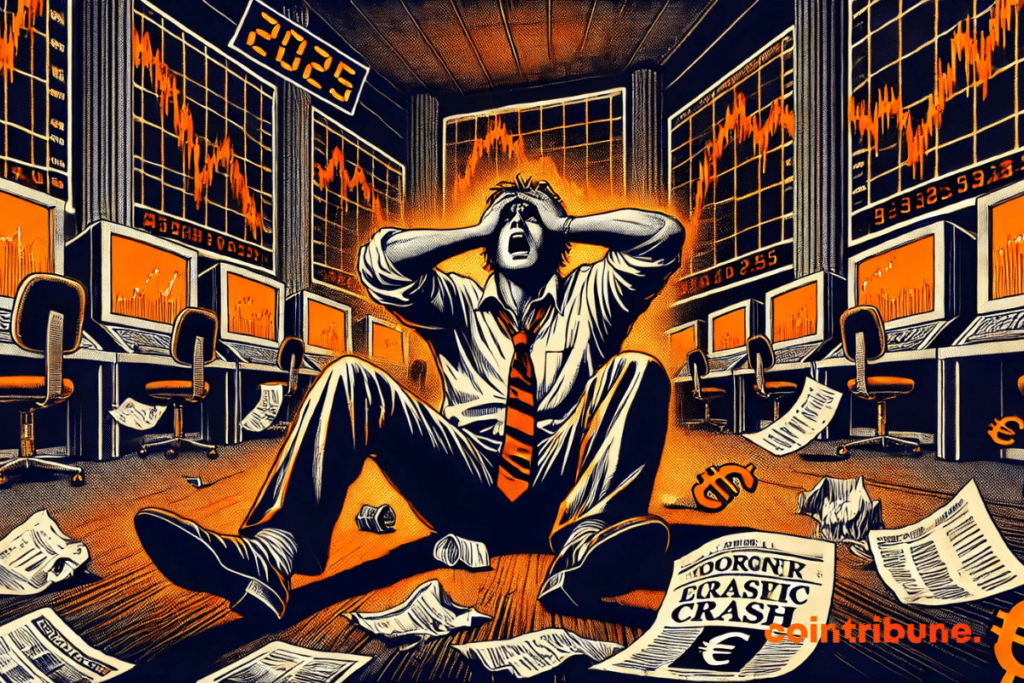IMF Cuts US Growth Forecast For 2025
In April 2025, the International Monetary Fund (IMF) darkened the economic outlook for the United States with a sharp revision: projected growth at 1.8%, compared to the 2.7% initially forecast. This reversal, the most significant since the 2008 crisis, is not a mere technical adjustment. It reflects a conjunction of risks – trade wars, persistent inflation, and a consumption slowdown – that threatens to reshape the global economic balance. Behind these figures lies a stark observation: recent policy decisions have triggered a shockwave whose aftershocks could last.

In Brief
- In April 2025, the IMF sharply downgraded US growth: 1.8% versus the initially forecast 2.7%, an unprecedented drop since 2008.
- The trade war reignited by Washington triggers a global domino effect.
- The specter of a recession is emerging in the US, with a 40% probability according to the IMF.
Trade War: The Domino Effect Shaking Forecasts
On April 2, 2025, the announcement of reciprocal tariffs by the Trump administration acted as a detonator. In less than ten days, the IMF had to rewrite its projections – a process usually spread over two months.
“A major negative shock,” according to the words of Pierre-Olivier Gourinchas, the institution’s chief economist. Markets immediately reacted: the S&P 500 plunged 9%, while the United States’ trading partners, from Europe to Asia, retaliated with symmetrical measures.
This protectionist escalation creates a vicious circle. Tariffs increase import costs, penalize companies dependent on global supply chains, and dampen investment.
The IMF highlights a paradox: these measures, intended to protect domestic industry, could ultimately reduce the productivity of the American manufacturing sector. “A real depreciation of the dollar is not excluded,” warns Gourinchas, mentioning a structural weakening.
However, the impact is not limited to the United States. Global growth undergoes a downward revision, reaching 2.8% (-0.5 points), revealing a worrying contagion.
Emerging countries, already weakened by a historically strong dollar, suffer double pressure: slowdown in American demand and rising costs of borrowing in foreign currencies. The IMF warns: this “improvised” trade war risks crystallizing a new regime of low growth.
Inflation: The Thorny Equation of Central Banks
In this volatile context, inflation becomes a puzzle. The IMF raises its forecasts for advanced economies to 2.5% in 2025 (+0.4 points), with a peak of 3% in the United States. The causes: strong prices in services, rising basic goods, and the direct effect of tariffs. “Logistical costs and raw materials pressures are underestimated,” notes the April report.
Central banks find themselves trapped. If tariffs are seen as temporary, a rate cut remains possible. But if they persist, fighting inflation will require monetary tightening, worsening the slowdown. The IMF now estimates the recession risk in the United States at 40% – up from 25% six months earlier. A nightmare scenario where stagflation and unemployment rise together.
Ironically, the dollar – traditionally a safe haven in turbulent times – began an unprecedented depreciation since March 2025. A counterintuitive dynamic linked to doubts about the future competitiveness of the American economy. “Exchange rates react less to trade shocks than to growth expectations,” analyses Gourinchas. For households, this drop in purchasing power is coupled with a weakening of confidence. Indeed, the consumption index, a pillar of the economy since 2020, shows signs of fatigue.
The IMF’s revision is not just a statistical adjustment. It marks a change of era, where unilateral political choices can shake fragile economic balances. Between trade wars, stubborn inflation, and monetary uncertainties, room for maneuver is shrinking.
The coming months will be decisive: will the United States succeed in bending the curve without causing a hard landing? The IMF, in any case, bets on caution – and implicitly reminds that today’s decisions shape the crises of tomorrow.
Maximize your Cointribune experience with our "Read to Earn" program! For every article you read, earn points and access exclusive rewards. Sign up now and start earning benefits.

Fascinated by Bitcoin since 2017, Evariste has continuously researched the subject. While his initial interest was in trading, he now actively seeks to understand all advances centered on cryptocurrencies. As an editor, he strives to consistently deliver high-quality work that reflects the state of the sector as a whole.
The views, thoughts, and opinions expressed in this article belong solely to the author, and should not be taken as investment advice. Do your own research before taking any investment decisions.